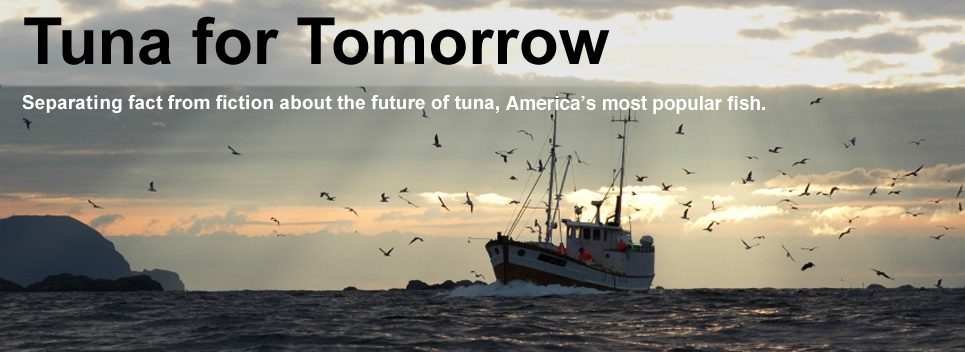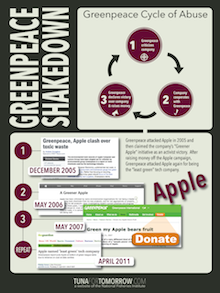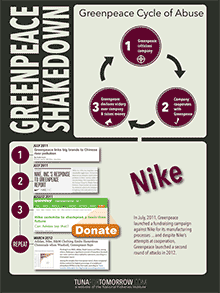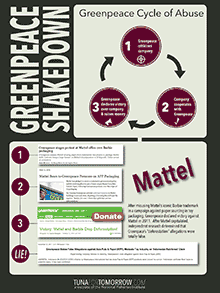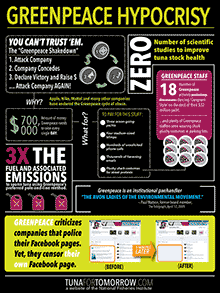from The Daily Caller
February 22, 2012
By Gavin Gibbons
On the surface it is easy to regard campaigns by the global environmental activist group Greenpeace as amusingly irreverent or, as PR Week, the trade magazine for public relations professionals, described one such recent attack against the toymaker Mattel, “compelling.” But if any news outlets would ever take a hard, scrutinizing look inside Greenpeace’s media relations tactics, they’d find a method rife with irresponsible harassment, inaccurate claims, and wildly unrealistic demands.
It turns out, for instance, that the broadside against Mattel was based entirely on Greenpeace’s misrepresentation of lab results that the activists claimed “show that packaging used by leading toy brands regularly contains Indonesian rainforest fibre.” But following that Greenpeace declaration and the fawning media coverage that resulted, the very lab that Greenpeace had enlisted denounced them as frauds. “We have not and are unable to identify country of origin of the samples,” the CEO of Integrated Paper Services, Bruce R. Shafer, said publicly. “We are unable to comment on the credibility of the statements Greenpeace has made regarding country of origin.”
The company that sourced the paper materials to Mattel, Asia Pulp & Paper, went even further, pointing out that some 95 percent of the packaging materials came from recycled paper and that the remaining 5 percent is sourced from environmentally certified forests around the world. So, not only was the paper environmentally upstanding, Greenpeace’s PR effort was, as AP&P put it, “completely unsubstantiated and false.”
A similar sort of attack by Greenpeace is currently underway against America’s most well-known canned tuna brands, each members of our trade association. Greenpeace is demanding, bizarrely, that all tuna be caught one at a time with a fishing pole. Seriously. Greenpeace has no answer for what this would cost consumers or the fuel, boats, and labor needed to pursue this antiquated method, one that could never hope to meet global demand.
And although Greenpeace insists it wants a “serious dialogue” on tuna sustainability, here are just some of the outlandish tactics they have been using:
● Posting online videos of violent and sexualized caricatures of the tuna companies’ cartoon mascots, all of which can be readily viewed by children.
â—Ź Manipulating unwitting people on street corners to place harassing, scripted phone calls to company switchboards.
● Dressing up a staffer in a plushy shark costume to accost parents and children in supermarket parking lots to tell them that “Nemo” may be killed.
● Encouraging their Facebook followers to place scripted robocalls to tuna companies, many of which include accusations of “rape,” “thievery,” “piracy” and assorted other threats.
Apparently that’s what passes for clever PR thinking at Greenpeace these days. But these are hardly exceptions. Recent campaigns of theirs against other companies have depicted popular children’s characters decapitating a tiger with a chainsaw, shooting a caged polar bear in the head, or having costumed children blown up from space by a “Volkswagen Death Star.”
But the tuna companies are taking a stand on principle. Along with conservationists like WWF and established governing bodies, we are taking part in the International Seafood Sustainability Foundation to protect the long-term viability of the world’s fisheries. Greenpeace, unsurprisingly, has refused a seat at the table.
That’s likely because causing immediate — and well-publicized — commercial harm to the companies they target is their real objective. That’s what gets them media attention, which translates into financial donations. Presumably it also strikes anxiety into future targets of Greenpeace bullying which, like the toymakers, are more likely to cave quickly than confront the accusations, no matter how patently false.
In the same issue in which Greenpeace’s destructive Mattel campaign was praised, PR Week editor Steve Barrett urges that “engagement, trust, and authenticity” ought to be core values, especially in “cause-related” activities. Readers might wonder when the magazine, or any other enterprising journalist for that matter, will apply those standards of examination to Greenpeace for a change.
But when we pointed out to Barrett that Greenpeace falsified lab results in the attack on Mattel — according to the very lab Greenpeace had hired — thereby deceiving the public (and, by extension, his own readers), Barrett was untroubled. “You can’t hide the fact that it got bucket loads of coverage — i.e., objective achieved for GP,” he wrote to us. “We don’t take moral/ethical/political stances … on the PR activities of campaigning groups.”
I somehow doubt the companies being fraudulently targeted would agree. But here’s another important public relations principle that we would encourage our fellow communicators to consider: Don’t let anyone stand between you and your customers with a threat.
For our part, we intend to speak directly to consumers about the ways in which self-interested, radical activist groups are co-opting the press in order to mislead the public about one of the most environmentally sound sources of protein and essential nutrients on the market. So far, it’s been going well. The feedback we’ve received from ordinary consumers indicates they are keenly aware how Greenpeace distorts the record and they know better than to listen to people who lurk in parking lots ranting at people. That anecdotal analysis is backed by a core piece of research: We know of no measurement showing that Greenpeace has the slightest impact on seafood sales.
Gavin Gibbons is the director of media relations for the National Fisheries Institute.


